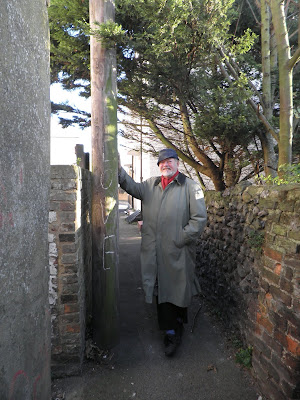 |
| "Roger Leaving" by Colin Rhodes (ink on paper, November 2019) |
Roger Cardinal will always be known as for his introduction of the term ‘outsider art’, conceived as an impressionistic attempt to create an anglophone equivalent for the French term, ‘art brut’, invented by the artist Jean Dubuffet in the 1940s. Ironically, as a linguist – Cardinal was fluent in French and German – he was comfortable with the French term. It was his publisher who insisted on inventing a new one for the history of the subject he published early in his career in 1972, for fear that an English and American market would not take to art brut. The term outsider art was taken up by dealers and collectors (many of them mainstream artists), especially from the end of the 1970s, and it came to embrace work from a much wider range of situations than Dubuffet envisaged. Cardinal always regretted this expansion and colonisation by a range of other sub-genres. He remained committed to his term, though, and continued to use it throughout his later writing on the subject, not least in his 1979 project with the art dealer Victor Musgrave for London’s Hayward Gallery, “Outsiders: an art without precedent or tradition.” It remained one of his few regrets that this major exhibition did not penetrate British culture more deeply or alter attitudes in universities towards its study as a serious subject.
Cardinal was far from one-dimensional in his interests. He had a lifelong passion for those areas of cultural production driven by ideas that fused the literary with the visual. He had a passion for Romanticism and made important contributions to scholarship on the subject. He wrote about Henry Moore, Paul Nash and Kurt Schwitters, and completed a manuscript on Prehistoric Art (as yet, unpublished). But it was probably his encounter with surrealism that most defined him, a movement to which he became enamoured while in Paris as a student of French at Cambridge University.
 |
| Roger in Margate, 27 November 2011 |
Cardinal shared the surrealists’ love of marginalised things, and of the revelations and beauty produced by the operations of chance. I remember many walks with him, when he would suddenly divert us down some alley, or wander into a store for no other reason than they might reveal something of hitherto unknown interest. He would constantly point at little, unusual details, a mannerism, or an interaction between people across the street.
His entanglement with surrealism also led him to Dubuffet, who he met in Paris at the end of the 1960s and with whom he corresponded, and to art brut. Like all good surrealists, Cardinal was not a joiner of clubs and associations. This did not prevent him from being invited to contribute to numerous publications and to speak, especially on outsider art, across the world. His presence often acted as a catalyst for things to happen, which I’m not sure he was not entirely aware of. A flowering of outsider art in Australia, for example, that occurred in the mid-1980s was in no small part a result of his presence in the country on a brief fellowship at the Australian National University. He occasionally accepted formal positions, for example as a juror for Triennial of Naïve Art and as a member of the consultative committee of the Collection de l’Art Brut in Lausanne, and he was closely associated as contributing editor with the British outsider art magazine Raw Vision from its inception in 1989.
 |
| R C in profile by Colin Rhodes (ink on paper, 2017) |
I have lost a dear friend, mentor and occasional sketching partner. He took me on many a surrealist ramble in places like Whitstable and Margate. We shared many a pub lunch. And we talked and talked about art and the artists we loved. There always seemed to be a book he owned that would fill a gap in my knowledge, or some acquaintance he had made that I would do well to look up. He was a gentle polymath and linguist; one of the most generous intellectuals I ever met. My heart goes out to Agnès. RIP Roger Cardinal (27 February 1940 - 1 November 2019).
 |
| Roger and Agnès Cardinal awaiting lunch at The Old Bell, Rye, 21 October 2017 |